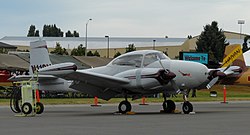Temco D-16
| Temco D-16 | |
|---|---|

|
|
| Type: | Small plane |
| Design country: | |
| Manufacturer: | |
| First flight: |
1952 |
| Commissioning: |
1953 |
| Production time: |
1953-1957 |
| Number of pieces: |
110 |
The Temco D-16 is an American light aircraft from the 1950s. It is the twin-engine version of the Ryan Navion and is therefore also called the Twin Navion , although the name is also often used for the later Camair 480 , which is also a twin-engine version of the Ryan Navion.
history
In 1951 Charles Daubenberger, owner of the Dauby Equipment Company, was looking for a cheap replacement for his company's Ryan Navion. The new aircraft should offer greater reliability for flights over high mountain regions. Daubenberger hired Roger Keeney from the Acme Aircraft Company to do the development. This order resulted in a twin-engine version of the Navion.
development and construction
Jack Riley Sr. built the first model with a team of four. By supporting Lycoming was four-cylinder engine Lycoming O-290 with 125 horsepower (92 kW ) as the engine selected. In addition to the use of various components of the Piper PA-18, construction changes compared to the Navion consist of reinforced wing ribs in order to be able to support the engines. In addition, new engine nacelles, an aerodynamic nose that replaced the engine and cowling, and a new tail unit based on the Navion's tail unit were developed. During testing in 1952, the aircraft was originally designated the X-16 Bi-Navion. On November 10, 1952, the machine received type certification by the Civil Aeronautics Administration and was then renamed the D-16 Twin Navion.
Jack Riley bought the rights to the construction from Dauby and had a second copy built, for which he required engines with at least 140 hp (103 kW). Then Riley Aircraft started production of the Riley D-16 Twin Navion with some improvements and Lycoming O-320 engines with 150 PS (110 kW). After 19 copies were built, Riley outsourced the production to Temco Aircraft as a subcontractor . Temco finally acquired the exclusive production rights and built another 46 copies under the name Temco D-16. In September 1954, the design was revised with O-340 engines from Lycoming and additional tanks at the wing ends. The official name was Temco D-16A, but the machine was mainly marketed under the name Riley 55 after its model year.
use
After 45 D-16A had been built, production was discontinued in 1957 due to cheaper competition such as the Piper PA-23 Apache . Many of the D-16s were converted to D-16A. In 2012, 52 D-16s and D-16As were still registered in the US and at least three copies are in museums.
Incidents
- On June 25, 1971, the D-16 with the registration number N91685 took off from Lake Tahoe , California . After the start, the 42-year-old pilot entered a banked turn at too low a speed. Due to a stall , the machine crashed and was completely destroyed. The pilot and a passenger were killed in the accident.
- On October 24, 1971, the D-16A with the registration number N709T flew at Dragoon in Arizona due to adverse weather conditions against a mountainside and was completely destroyed in the process. The 37-year-old pilot was killed on impact.
- On March 24, at the 1974 D-16 coincided with the characteristics N5232K during a training flight in the traffic pattern of the airfield of Marietta in Georgia one engine out. On its final approach, the machine brushed against some trees and crashed. The aircraft was destroyed, the 35-year-old pilot and his flight instructor were injured.
- On July 12, 1991, the D-16A with the registration number N88T crashed at Eau Claire in Michigan due to a lack of fuel due to a fuel selector lever that was not correctly installed after maintenance . The aircraft was badly damaged and the 64-year-old pilot was killed.
Technical data (D16)
| Parameter | Data |
|---|---|
| crew | 1 |
| Passengers | 3 |
| length | 27,166 ft (8.3 m ) |
| span | 33,333 ft (10 m ) |
| height | 9.5 ft (3 m ) |
| Wing area | 178.3 ft² (16.6 m² ) |
| Empty mass | 2,300 lb (1,043 kg ) |
| Max. Takeoff mass | 3,350 lb (1,520 kg) |
| Cruising speed | 148 kn (274 km / h ) |
| Top speed | 157 kn (291 km / h) |
| Service ceiling | 20,000 ft (6,096 m) |
| Range | 609 NM (1,128 km ) |
| Engines | 2 × Lycoming O-320 |
Web links
Individual evidence
- ^ Gene Smith: The Man Who Invented the STC . In: Air Progress . September 1989 (English).
- ^ A b c Rod Simpson: Airlife's World Aircraft . Airlife Publishing, 2001, ISBN 1-84037-115-3 (English).
- ^ A b R. W. Simpson: Airlife's General Aviation . Airlife Publishing, 1995, ISBN 1-85310-577-5 (English).
- ^ Bob Ogden: Aviation Museums and Collections of North America . Air-Britain, 2007, ISBN 0-85130-385-4 (English).
- ↑ NTSB Identification: OAK71AP055. NTSB , accessed February 14, 2020 .
- ↑ NTSB Identification: LAX72AL029. NTSB , accessed February 14, 2020 .
- ↑ NTSB Identification: MIA74FKG63. NTSB , accessed February 14, 2020 .
- ^ National Transportation Safety Board - Aviation Accident Final Report. NTSB , accessed February 14, 2020 .